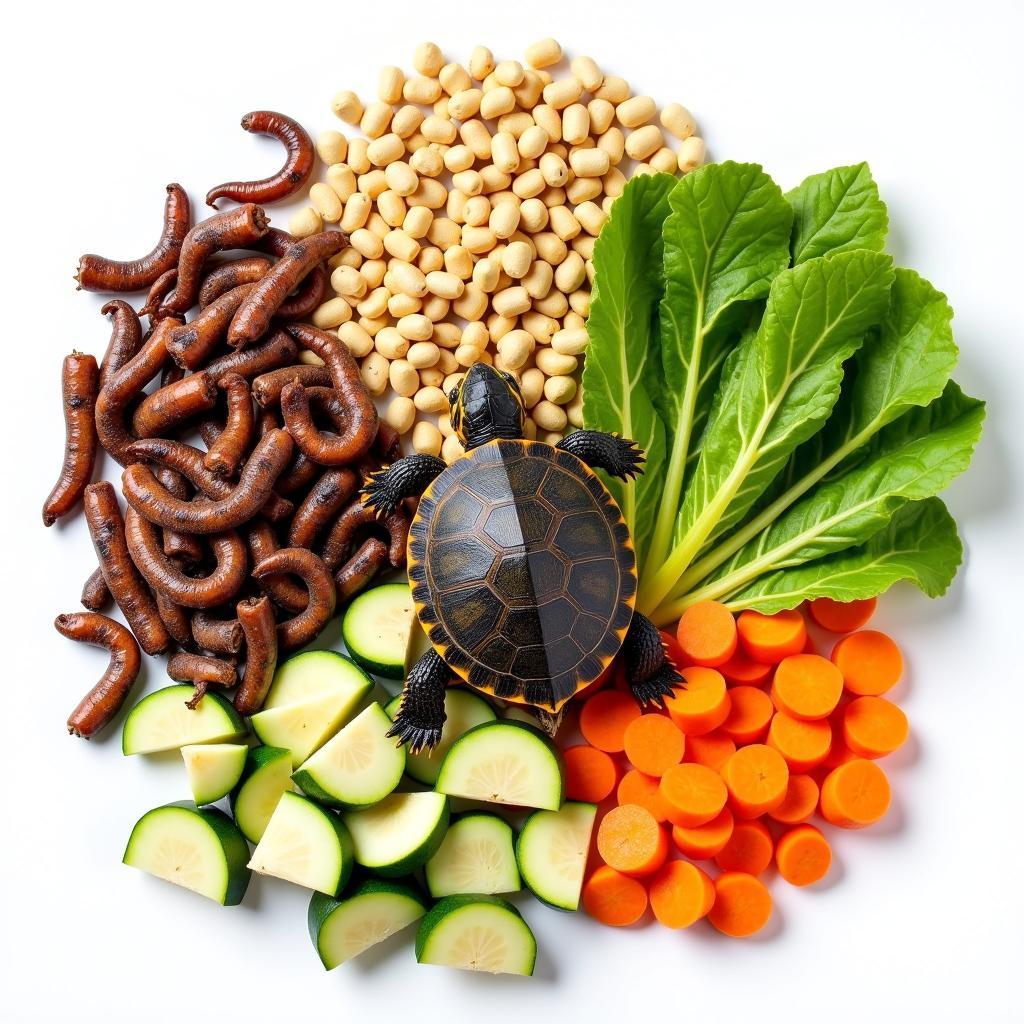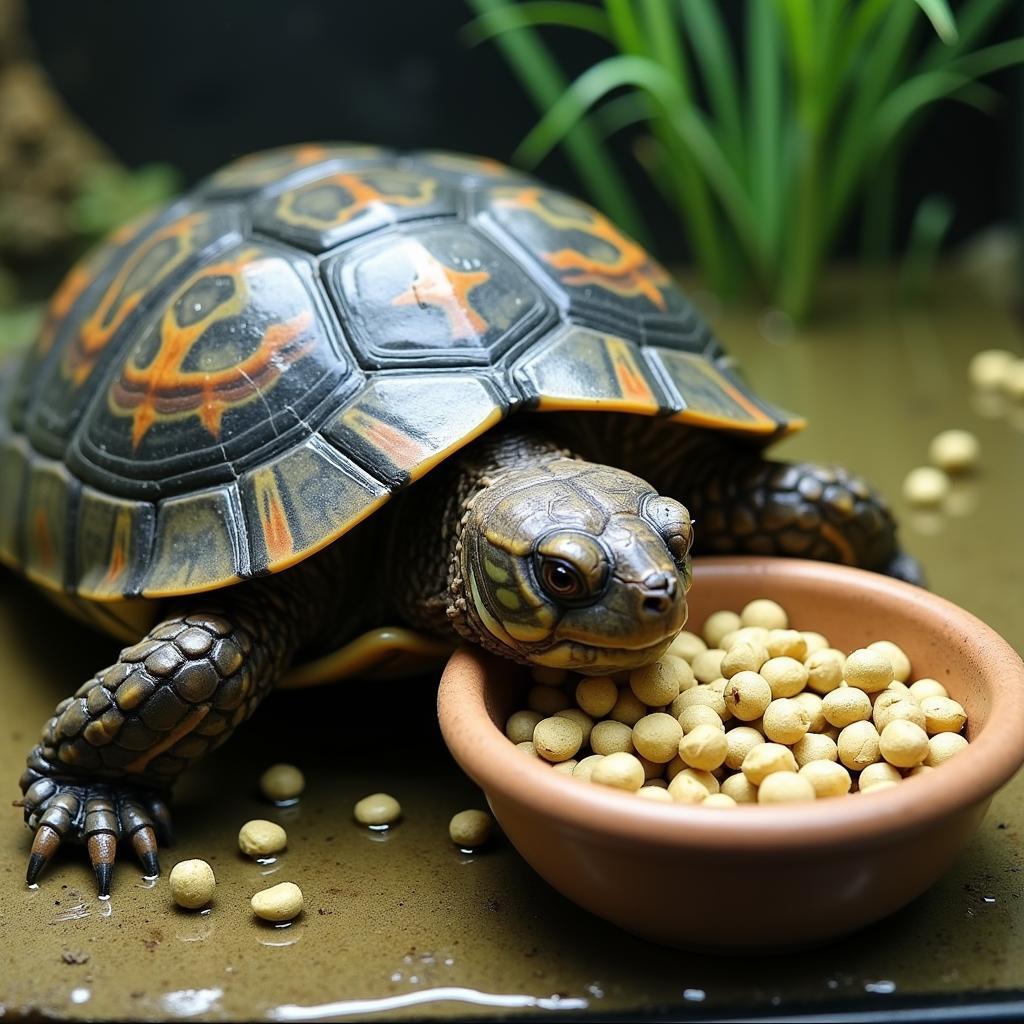Mud turtles, with their charming personalities and relatively low-maintenance care requirements, make fantastic pets for reptile enthusiasts of all levels. However, one area that often confuses new owners is their diet. What do mud turtles eat? How often should you feed them? And what are some important things to keep in mind when crafting a balanced diet for your shelled friend? This comprehensive guide will delve into everything you need to know about Mud Turtle Food, ensuring your pet thrives under your care.
Understanding Your Mud Turtle’s Dietary Needs
Mud turtles are omnivores, meaning their diet consists of both animal and plant matter. In the wild, they are opportunistic feeders, consuming a varied diet based on availability. This includes insects, worms, crustaceans, small fish, algae, aquatic plants, and even carrion.
It’s crucial to replicate this dietary diversity in captivity to ensure your mud turtle receives all the necessary nutrients for optimal health. A lack of variety can lead to nutritional deficiencies, impacting their growth, immune system, and overall well-being.
What to Feed Your Mud Turtle
When it comes to mud turtle food, you have a range of options:
Commercial Turtle Pellets: These are readily available at most pet stores and provide a balanced blend of essential nutrients. Look for pellets specifically formulated for aquatic turtles, and choose a size appropriate for your turtle’s age.
Live Foods: Live foods are a great way to stimulate your turtle’s natural hunting instincts and provide enrichment. Suitable options include:
- Insects: Crickets, mealworms, waxworms (in moderation), earthworms, and silkworms
- Worms: Bloodworms, blackworms, and white worms
- Aquatic invertebrates: Snails, ghost shrimp, and daphnia
Fresh Produce: While animal protein should make up the majority of a mud turtle’s diet, incorporating fresh produce is essential for providing vitamins, minerals, and fiber. Offer your turtle a variety of:
- Leafy Greens: Dandelion greens, collard greens, romaine lettuce, and spinach (in moderation)
- Aquatic Plants: Duckweed, water hyacinth, and water lettuce
- Vegetables: Zucchini, carrots, bell peppers (all cut into small pieces)
 Variety of mud turtle food
Variety of mud turtle food
How Often and How Much to Feed
The frequency and amount of food you give your mud turtle will depend on its age, size, activity level, and metabolism. As a general guideline:
Hatchlings and Juveniles (under 2 years): Feed daily, offering as much food as they can consume in about 15 minutes.
Adults (2 years and older): Feed every other day or 2-3 times a week, offering a portion about the size of their head.
Important Considerations:
- It’s best to feed your turtle in the morning, allowing them ample time to digest their food before the evening.
- Remove any uneaten food after 15-20 minutes to prevent water contamination.
Creating a Balanced Diet
A balanced diet is crucial for your mud turtle’s long-term health and well-being.
“A common mistake owners make is not providing enough variety in their turtle’s diet,” says Dr. Emily Carter, a veterinarian specializing in reptile care. “Just like us, turtles need a diverse range of nutrients from different sources to thrive. Don’t be afraid to experiment with different food items and see what your turtle enjoys.”
Here’s a sample feeding schedule for a mud turtle:
Day 1: Commercial turtle pellets
Day 2: Live crickets and chopped zucchini
Day 3: Bloodworms and a small piece of banana (as a treat)
Day 4: Fast day
Day 5: Commercial pellets and duckweed
Remember to adjust this schedule based on your turtle’s individual needs and preferences.
 Mud turtle eating pellets from a bowl
Mud turtle eating pellets from a bowl
Mud Turtle Food: FAQs
Q: Can I feed my mud turtle only commercial pellets?
While commercial pellets offer a balanced diet, it’s still important to supplement with live foods and fresh produce for enrichment and to ensure a complete nutritional profile.
Q: What are some good sources of calcium for my mud turtle?
Calcium is crucial for strong bones and shell health. Offer calcium-rich foods like whole small fish (with bones), snails, and leafy greens. You can also use a calcium supplement, dusting it over their food 2-3 times a week.
Q: My mud turtle refuses to eat. What should I do?
Loss of appetite can be a sign of stress, illness, or improper husbandry. Ensure their tank parameters are correct, offer a variety of food items, and consult a veterinarian experienced with reptiles if the problem persists.
Ensuring Your Mud Turtle Thrives
Providing a nutritious and varied diet is fundamental to responsible mud turtle ownership. By understanding their dietary needs, offering a diverse menu, and closely observing their eating habits, you can ensure your shelled friend lives a long, healthy, and fulfilling life. If you have any concerns about your mud turtle’s diet or health, always consult a qualified veterinarian for personalized advice.
Need help with your mud turtle’s dietary needs? Contact Mina Cones Food at 02437655121, [email protected] or visit us at 3PGH+8R9, ĐT70A, thôn Trung, Bắc Từ Liêm, Hà Nội, Việt Nam. Our team of pet care experts is available 24/7 to assist you.